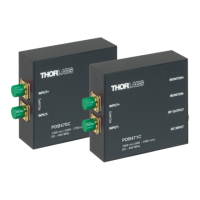© 2019 Thorlabs
5 Appendix
11
5 Appendix
Comments and explanations to the individual specifications
- Typical responsivity is the responsivity Â(l) of the photo diode at the stated wavelength.
- Transimpedance [V/A] is the ratio of output voltage to photo current, it is wavelength inde-
pendent.
- Conversion gain [V/W] is the ratio of output voltage to input optical power, by other words
G
CONV
= G
TRANS
× Â(l)
This formula shows, that the conversion gain is dependent on the actual wavelength. In
specifications, it is given only for the indicated operating wavelength.
- NEP (Noise Equivalent Power) is stated for 30 kHz to 100 MHz frequency range.
- Overall output voltage noise [V
RMS
] is the value which can be measured across a 50 W
load at large bandwidth, e.g., if connect the RF output to a 50 W terminated scope input.
- Max. input power is the damage threshold of the photo diode.
- Typical noise spectra (diagrams): These spectra were measured using an electrical spec-
trum analyzer (resolution bandwidth 100 kHz, video bandwidth 10 kHz). The INPUTs of the
balanced detectors under test were blocked. The lower curve in the diagram was measured
with the same setup and the balanced detectors under test switched off, i.e., it represents
the measurement system’s noise floor.
- Monitor outputs are designed for use with high impedance loads (e.g., high-Z scope input
etc.), but can also drive 50 W loads. Monitor outputs conversion gain is given for the indic-
ated operating wavelength and high impedance load.
- Typical frequency response curves are measured using the setup described in section
"CMRR and Frequency Response"
8

